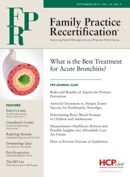Publication
Article
Family Practice Recertification
Patient Participation in the Electronic Health Record Process
Author(s):
As more practices and hospitals enter the digital age with Electronic Health Records (EHR) and other health information technology tools, a recent article points out that all those efforts are only half the battle.
As more practices and hospitals enter the digital age with Electronic Health Records (EHR) and other health information technology tools, a recent article points out that all those efforts are only half the battle.
In a story posted on Health IT Buzz, authors Vaishali Patel, PhD, MPH, and Erin Siminerio note that while health care professionals can spend the money and invest the resources to get the top-of-the-line products available on the market, it does not do any good if the patients are not interested in using them as well. Part of their argument is based on a brief from the Office of the National
Coordinator of Health Information Technology, of which Patel was one of the authors.
In their article, the authors compare the relationship between health care providers and their patients to a dance, with both needing to be equal partners for the EHR records to prove beneficial. They noted that it was just one year ago when studies said only 3 in 10 patients could even have access to their records, making it a still developing tool.
“This is likely related to providers’ limited capabilities prior to implementation of Stage 2 Meaningful Use,” they said. “We expect this percentage will grow as providers’ capabilities increase.”

The authors also said that while the number is low, the threshold for successful Stage 2 implementation for practitioners is just 5% of patients who have access to their records and take advantage of the opportunity at least once. “In this survey, almost half of all individuals given online access viewed their record at least once,” they reported.
Another variable in the equation, according to the authors, is what patients choose to do when they are given access to their records. Their research showed that nearly half shared the information they received with other people, including their doctors, “suggesting that their online record is potentially being used to address gaps in information exchange among providers.”
Patients also reported not only viewing their data online but also downloading it to keep as a record of their own either on a computer or other mobile device. The authors also noted that one in 10 patients surveyed sent the information they received to another location, “enabling them to better manage their health care needs.”
The number of patients accessing their information through digital means may not be as high as it could be, or as high as it will be in the future, but the authors noted that those that are taking advantage of the opportunities available to them are providing largely positive feedback.
“A majority of those that accessed their online record considered the information very useful,” they noted. “Even among the survey respondents who did not access their medical records online, a majority viewed secure online access to those records as very or somewhat important, and this was nearly universal among those who did access their online record.”





